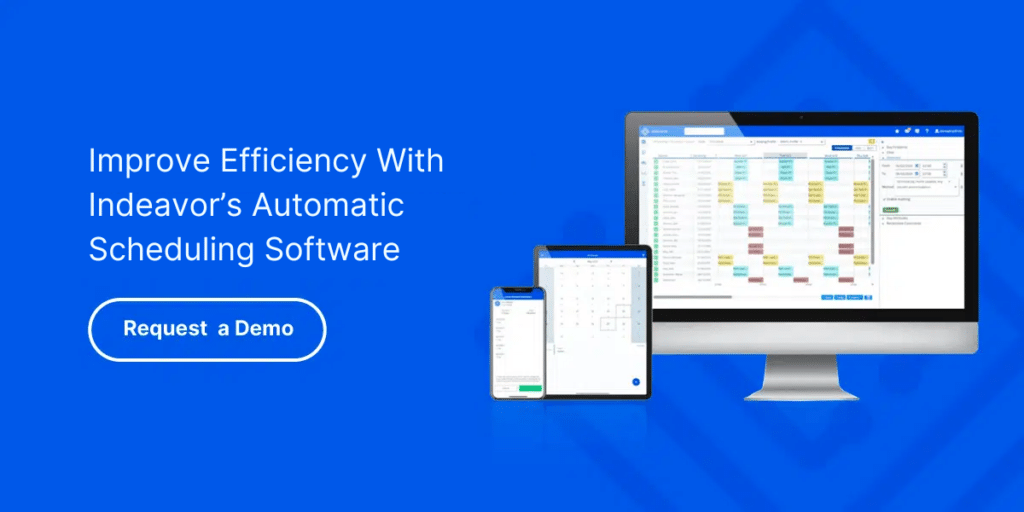Why Shift Planning Is More Critical Than Ever
From consumer packaged goods, hospitals, logistics warehouses, and energy providers, operations have become increasingly complex—and so has managing the frontline workforce. With fluctuating demand, compliance regulations, union agreements, and rising labor costs, one thing is clear: traditional shift planning methods are no longer cutting it.
Shift scheduling is no longer a back-office task—it’s a strategic lever for improving efficiency, employee satisfaction, and profitability. Organizations that fail to modernize their approach risk everything from high absenteeism and burnout to costly regulatory fines.
The Hidden Costs of Manual Shift Scheduling
A typical employee spends 30-40% of their time looking for written-down information. Think about how much time you’ve wasted searching for documents in disorganized filing cabinets or for a misplaced sticky note. Prioritizing cloud-based solutions over paper will grant you access to pertinent data right at your fingertips; that way, you can use that time previously spent looking for an employee’s leave request form on tasks that actually move the business forward.
Manual scheduling methods—like spreadsheets, whiteboards, or even legacy digital tools—can create major bottlenecks across operations.
- Time Drain on Managers: Building schedules manually can take hours or even days, especially when trying to balance availability, qualifications, and labor laws.
- Human Error: Double-bookings, missed shifts, and non-compliant rosters are all too common when relying on outdated processes.
- Lack of Transparency: Employees often receive schedules too late or in an inconsistent format, leading to confusion and last-minute call-offs.
- Limited Flexibility: Managers struggle to accommodate changes, while employees have few options to swap shifts or request time off without creating chaos.
These inefficiencies don’t just hurt morale—they increase overtime costs, disrupt production, and hurt your bottom line.

What It Really Means to Streamline Shift Planning
Streamlining shift planning means transforming it from a reactive task to a proactive, intelligent process. It involves replacing manual workarounds with automated systems that account for everything from individual employee qualifications to peak operational demand.
The result? A more agile, data-informed approach to workforce management. Employees gain more control and visibility into their schedules, while managers are freed up to focus on higher-value activities. And perhaps most importantly, the business becomes more resilient and cost-effective.
Key Benefits of Streamlined Shift Planning
- Optimized Labor Allocation: Assign the right person to the right shift based on certifications, seniority, or labor agreements—every time.
- Real-Time Adaptability: Adjust shifts on the fly to accommodate call-offs, spikes in demand, or unplanned absences.
- Improved Employee Experience: With mobile access to schedules, employees can easily swap shifts, volunteer for overtime, or request leave.
- Compliance Confidence: Automatically enforce rest requirements, fatigue rules, union rules, and government regulations.
- Reduced Administrative Overhead: Automated scheduling reduces hours spent each week building and maintaining rosters.
Modern Shift Scheduling Tools: What to Look For
When evaluating scheduling platforms, it’s important to look beyond the basics. Modern shift scheduling tools should offer dynamic functionality that aligns with the complexity of your workforce.
The best tools include demand forecasting, mobile access, automated rules enforcement, and integration with payroll and timekeeping systems. They should allow employees to interact with their schedules on their own—without needing to call a supervisor or send an email for every small change.
Even more important, the tool should evolve with your business—scaling to support multiple locations, roles, and labor policies without missing a beat.
How to Make Shift Planning Effortless
For organizations operating in complex, high-pressure environments, the key to effective shift planning is automation, visibility, and accessibility. The most successful workforce planners are moving away from spreadsheets and static schedules—and toward dynamic, rule-based systems that adjust in real time.
Here are a few proven strategies to streamline your shift planning process:
- Automate the routine: By using scheduling tools that factor in qualifications, availability, and labor rules, you can build compliant, optimized rosters in minutes—not hours.
- Empower employees: Shift planning apps that give workers mobile access to their schedules—along with the ability to volunteer, swap shifts, or request time off—boost engagement and reduce administrative burden.
- Align with demand: Smart shift scheduling tools help you adjust labor based on real-time production needs, ensuring you’re never over- or under-staffed.
- Track qualifications and compliance: Assigning the right person to the right shift isn’t just about coverage—it’s about safety, legal requirements, and operational efficiency.
As your organization scales or takes on more complex operations (like 24/7 coverage, unionized workforces, or regulated industries), the risks of manual or outdated systems increase significantly. Investing in the right infrastructure upfront helps prevent burnout, reduce costs, and drive continuous improvement across your labor strategy.
Ultimately, shift scheduling isn’t just about filling slots on a calendar. It’s a strategic function that impacts employee satisfaction, compliance, and business outcomes. The organizations that treat it as such—and equip themselves with the tools to do it well—are the ones that stay ahead.
As workforce expectations evolve and operational demands fluctuate, your approach to planning shifts must evolve with them. Whether you’re leading a manufacturing plant, managing a distribution hub, or overseeing a healthcare facility, adopting a streamlined, tech-enabled scheduling process can unlock new levels of agility and resilience. Now is the time to rethink the way you plan, assign, and adapt—because smarter shift planning isn’t just a competitive advantage, it’s a business imperative.



